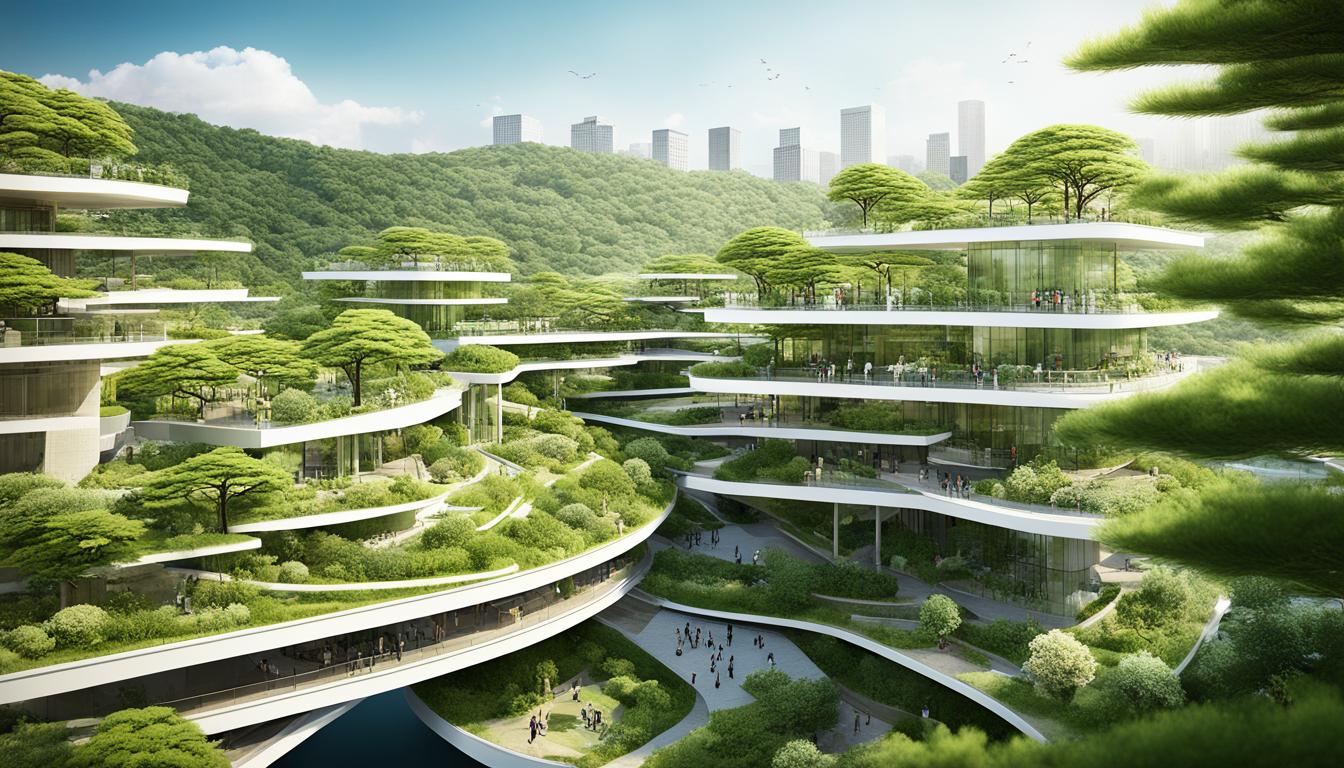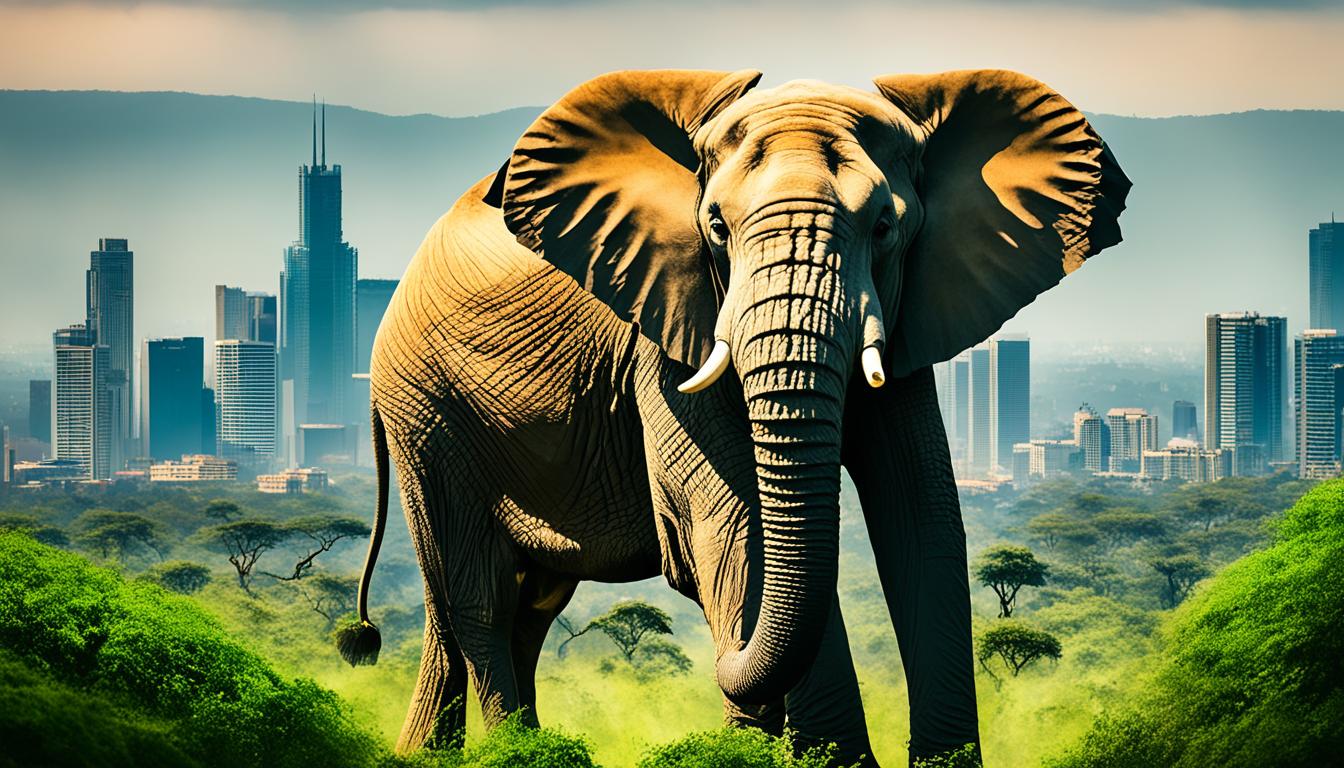Jordan Biodiversity and the Built Environment
Did you know that Jordan is home to diverse ecosystems that support a wide range of flora and fauna, including endemic species like the Serhani fish and Dead Sea gara? However, Jordan’s biodiversity is under threat from anthropogenic activities such as intensive agriculture, over-grazing, and urbanization.
Key Takeaways:
- Jordan is rich in biodiversity, with diverse ecosystems and endemic species.
- Anthropogenic activities pose significant threats to Jordan’s biodiversity.
- Conservation efforts are being made through the establishment of nature reserves and sustainable development practices.
- Sustainable architecture and urban planning initiatives contribute to biodiversity conservation in Jordan.
- Jordan aims to create a harmonious relationship between the built environment and the natural surroundings for a sustainable future.
Jordan’s Unique Ecosystems
Jordan is renowned for its diverse ecosystems, which encompass a range of landscapes including deserts, highlands, sub-tropical areas, and freshwater systems. These diverse habitats provide a home to a wide variety of flora and fauna, making Jordan a haven for biodiversity.
In these unique ecosystems, you can find an array of endemic species that are found nowhere else in the world. These species have adapted to the specific conditions of Jordan’s natural habitats, resulting in fascinating and distinct flora and fauna. An example of an endemic species in Jordan is the Serhani fish, which can be found in the Azraq Wetland Reserve. Another unique species is the Dead Sea gara, a fish that is native to the Dead Sea area.
The distinctive ecosystems and diverse flora and fauna contribute to the rich biodiversity of Jordan, attracting nature enthusiasts and scientists from around the globe. Exploring these natural wonders allows visitors to witness the beauty and resilience of Jordan’s ecosystems, while also understanding the importance of conservation efforts in preserving these delicate environments.
Threats to Biodiversity in Jordan
The biodiversity in Jordan is facing numerous threats from anthropogenic activities. Intensive agriculture, use of agrochemicals, over-grazing, unplanned development, urbanization, and pollution have led to habitat destruction and biodiversity loss. The First and Second World Wars had a significant impact on Jordan’s biodiversity, with the introduction of hunting and the depletion of some wildlife populations. Water scarcity and over-extraction have also affected biodiversity, leading to the degradation of wetlands and the loss of migratory bird populations.
Intensive agriculture and the use of agrochemicals have had detrimental effects on Jordan’s biodiversity. Pesticides and fertilizers can contaminate water bodies and soil, negatively impacting aquatic and terrestrial ecosystems. Over-grazing, especially in rangeland areas, has resulted in the degradation of vegetation and soil erosion, further exacerbating the loss of biodiversity. Unplanned development and urbanization have led to the destruction of natural habitats, fragmenting ecosystems and displacing wildlife.
The consequences of habitat destruction and biodiversity loss in Jordan are far-reaching. The disruption of natural ecosystems disrupts ecological processes and can lead to the decline or extinction of species. This loss of biodiversity not only affects the balance of ecosystems but also poses threats to human well-being. Many species play key roles in ecosystem services, such as pollination, water filtration, and pest control. The loss of these services can have cascading effects on the environment and human livelihoods.
“The loss of biodiversity not only affects the balance of ecosystems but also poses threats to human well-being.”
The depletion of biodiversity in Jordan is a pressing concern that requires immediate attention and action. Conservation efforts, including the establishment of protected areas and nature reserves, are critical for safeguarding the country’s unique ecosystems and endemic species. Collaboration among governmental bodies, conservation organizations, and local communities is essential for implementing sustainable practices and mitigating the threats to biodiversity. By addressing these issues and working towards sustainable development, Jordan can protect its natural heritage for future generations.
Conservation Efforts in Jordan
Jordan has taken significant steps to preserve and protect its rich biodiversity through the establishment of nature reserves and protected areas. These conservation efforts are vital for safeguarding the country’s unique ecosystems and endemic species.
The Royal Society for the Conservation of Nature (RSCN) plays a crucial role in managing nature reserves in Jordan, working tirelessly to ensure the conservation of the country’s natural heritage. Some of the prominent nature reserves managed by RSCN include:
- Shaumari Wildlife Reserve
- Azraq Wetland Reserve
- Ajloun Forest Reserve
- Mujib Nature Reserve
- Dana Nature Reserve
- Wadi Rum Protected Area
These nature reserves serve as important havens for various plant and animal species, providing a safe space for their survival and allowing researchers to study and better understand Jordan’s biodiversity. The reserves are carefully managed, ensuring that habitats are protected and wildlife populations are conserved.
In addition to the RSCN, several other conservation organizations in Jordan actively contribute to the protection of biodiversity. One notable organization is the Aqaba Special Economic Zone Authority (ASEZA), responsible for managing the Aqaba Marine Park. This protected area focuses on preserving the marine ecosystems and promoting sustainable practices to sustain the coastal biodiversity.
Through the combined efforts of these conservation organizations and stakeholders, Jordan continues to make strides in biodiversity conservation and ensure the long-term sustainability of its natural resources.
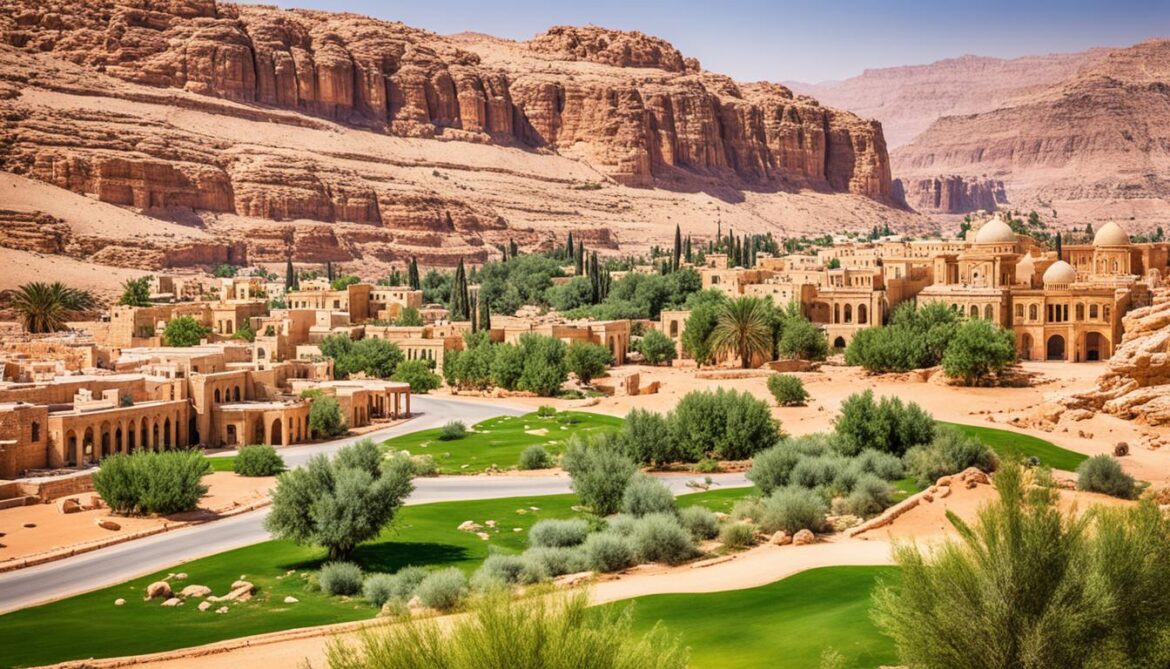
Key Points:
– Jordan has established nature reserves and protected areas to conserve its biodiversity. These include the Shaumari Wildlife Reserve, Azraq Wetland Reserve, and Aqaba Marine Park, among others.
– The Royal Society for the Conservation of Nature (RSCN) plays a crucial role in managing these nature reserves to protect Jordan’s unique ecosystems and endemic species.
– Other organizations, such as ASEZA, also contribute to biodiversity conservation efforts in Jordan.
Sustainable Development Practices in Jordan
Jordan is committed to sustainable development practices that aim to mitigate the impact of urbanization and promote biodiversity conservation. The country recognizes the importance of creating environmentally-friendly and resilient cities that harmonize with the natural surroundings and preserve biodiversity. Through the adoption of sustainable urban planning initiatives, the integration of green infrastructure, and the implementation of ecological design principles, Jordan is taking significant steps towards achieving its sustainability goals.
One of the key aspects of sustainable development in Jordan is the focus on sustainable urban planning. By considering the ecological, social, and economic factors, urban planners in Jordan strive to create cities that are both livable and environmentally friendly. This involves the development of compact and walkable neighborhoods, efficient land use planning, and the creation of accessible green spaces. Sustainable urban planning not only enhances the quality of life for residents but also helps to preserve biodiversity by protecting natural habitats.
“Sustainable urban planning is crucial for creating cities that support both human well-being and the natural environment.” – Dr. Sami Dakhil, Urban Planner
Promoting Green Infrastructure
Green infrastructure plays a vital role in sustainable development in Jordan. It refers to the integration of natural elements such as parks, green spaces, and urban forests into the built environment. Green infrastructure provides numerous benefits, including improving air and water quality, reducing urban heat island effects, and enhancing biodiversity. Jordan is committed to creating green infrastructure networks that connect urban areas with natural landscapes, allowing for the movement of wildlife and the preservation of ecological corridors.
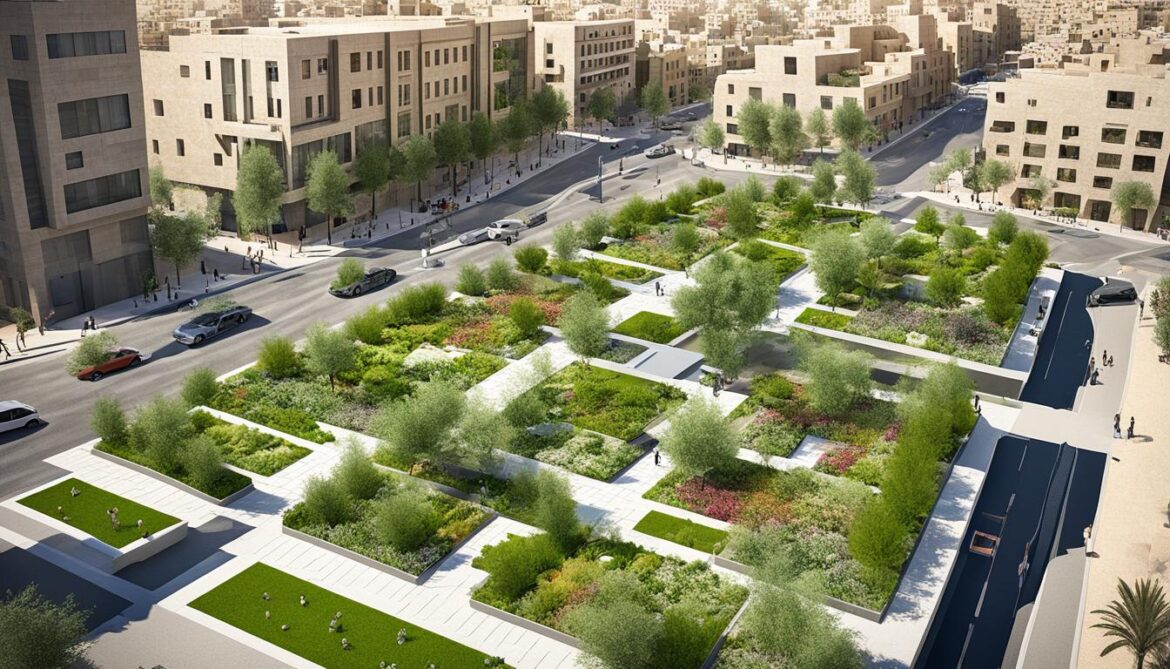
Implementing Ecological Design Principles
Ecological design principles are essential in ensuring the long-term sustainability of development projects in Jordan. This approach emphasizes the conservation and restoration of natural ecosystems, the use of native plant species, and the promotion of biodiversity. By incorporating ecological design into land use planning and landscape architecture, Jordan aims to minimize environmental impact and create resilient and sustainable landscapes. The integration of green roofs, rainwater harvesting systems, and native plantings are just a few examples of how ecological design is being implemented in Jordan.
| Sustainable Development Practices in Jordan | Benefits |
|---|---|
| Sustainable urban planning | – Livable cities – Preserves biodiversity – Enhances quality of life |
| Green infrastructure | – Improves air and water quality – Reduces urban heat island effects – Enhances biodiversity |
| Ecological design | – Minimizes environmental impact – Creates resilient landscapes – Promotes sustainability |
Jordan’s commitment to sustainable development is evident in the National Green Growth road map and action plan. By prioritizing sustainable practices such as green infrastructure and ecological design, Jordan is paving the way for a greener and more sustainable future.
Environmental Impact on Biodiversity in Jordan
The environmental impact on biodiversity in Jordan is significant, with water scarcity, air pollution, and waste management being key concerns. These factors have a profound effect on the delicate balance of ecosystems and the diverse flora and fauna that inhabit them.
Water Scarcity and Biodiversity in Jordan
Water scarcity poses a major threat to biodiversity in Jordan. The country’s arid climate and limited water resources have led to the degradation of wetlands, which are important habitats for a variety of species. Wetlands play a crucial role in providing breeding grounds for migratory birds and supporting unique aquatic ecosystems. The decline in wetland areas due to water scarcity has resulted in a significant decline in migratory bird populations, impacting the rich biodiversity of Jordan’s landscapes.
Air Pollution and Biodiversity in Jordan
Air pollution, particularly from industrial activities and transportation, has detrimental effects on biodiversity, particularly in urban areas of Jordan. Pollution from vehicle emissions and industrial pollutants can have direct negative impacts on plant and animal species, affecting their health and reproductive capabilities. The poor air quality in urban environments can also lead to the decline of certain species that are unable to adapt to the pollution levels.
Waste Management and Biodiversity in Jordan
Efficient waste management practices are crucial to prevent pollution and minimize the impact on biodiversity in Jordan. Improper disposal of waste can contaminate land, water, and air, leading to habitat destruction and the poisoning of wildlife. Implementation of comprehensive waste management strategies, including recycling and proper disposal facilities, is essential to protect the diverse ecosystems and wildlife that call Jordan home.
Addressing these environmental challenges is vital to ensure the long-term conservation and preservation of Jordan’s rich biodiversity. By promoting sustainable practices, such as water conservation, reduction of air pollutants, and responsible waste management, Jordan can minimize its ecological footprint and create a more harmonious coexistence between human activities and the natural environment.
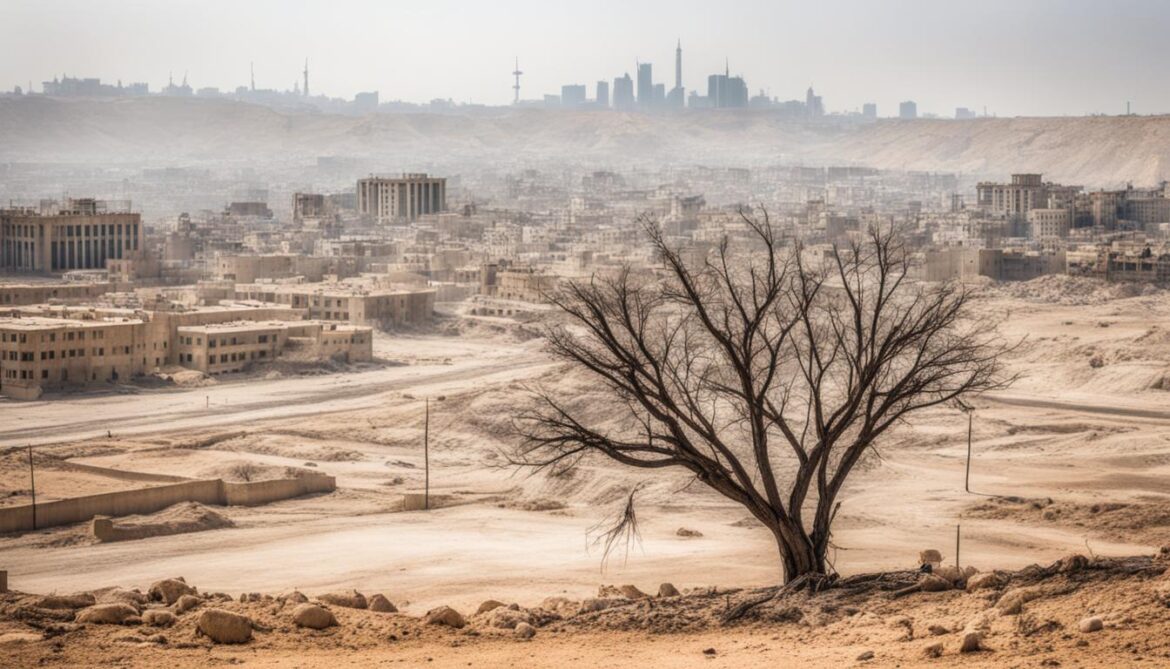
Sustainable Architecture in Jordan
Jordan is at the forefront of sustainable architecture, implementing eco-friendly building practices that contribute to reducing the environmental impact of structures. These sustainable design principles prioritize energy efficiency, renewable energy sources, and the use of sustainable materials.
Eco-friendly buildings are designed to minimize resource consumption, reduce greenhouse gas emissions, and create healthier and more environmentally-friendly living and working spaces in Jordan. They incorporate passive design strategies to maximize natural lighting and ventilation, reducing the need for artificial lighting and air conditioning.
In addition, green building practices are becoming increasingly prevalent in Jordan. These practices focus on water-saving measures, rainwater harvesting systems, and the use of low-flow fixtures to optimize water usage and reduce water waste in buildings.
“Sustainable architecture is a vital component of Jordan’s commitment to environmental conservation and sustainable development. By integrating energy-efficient technologies and green building practices, we can create buildings that harmonize with the natural environment and contribute to the overall well-being of our communities.”
Moreover, sustainable architecture in Jordan promotes the use of locally sourced and recycled materials, reducing the carbon footprint associated with transportation and minimizing waste generation.
By embracing sustainable architecture, Jordan is leading the way in promoting eco-friendly buildings and contributing to a more sustainable future. These practices not only benefit the environment but also create healthier and more comfortable living and working spaces for residents and occupants.
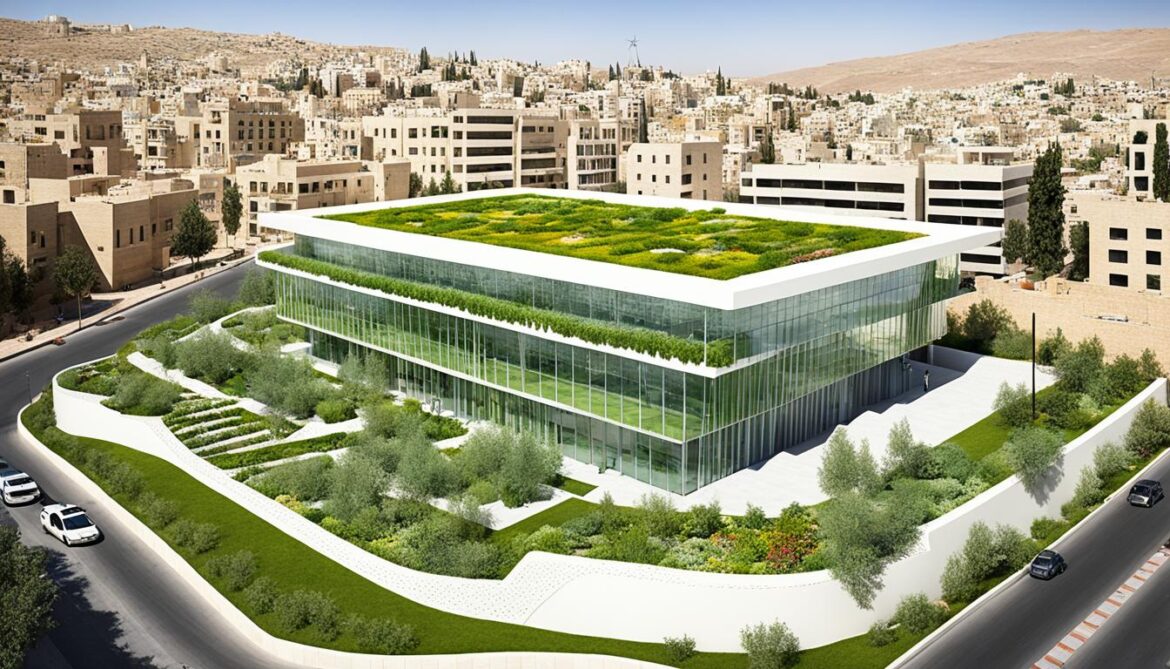
The Benefits of Sustainable Architecture in Jordan
Sustainable architecture in Jordan brings a range of benefits both for individuals and the broader community. Some of the key advantages include:
- Reduced energy consumption and lower utility costs
- Improved indoor air quality and occupant health
- Enhanced resilience to climate change
- Preservation of natural resources
- Creation of green jobs and economic growth
These benefits highlight the importance of adopting sustainable building practices in Jordan and serve as a model for other countries striving to achieve environmental sustainability.
| Benefits of Sustainable Architecture in Jordan | Description |
|---|---|
| Reduced energy consumption and lower utility costs | Eco-friendly buildings in Jordan significantly reduce energy consumption through efficient design and the use of renewable energy sources, resulting in lower utility costs for residents and businesses. |
| Improved indoor air quality and occupant health | Sustainable buildings prioritize good indoor air quality by using non-toxic materials, incorporating natural ventilation systems, and promoting access to daylight, creating healthier living and working environments for occupants in Jordan. |
| Enhanced resilience to climate change | Eco-friendly buildings in Jordan are designed to be more resilient to the impacts of climate change, such as extreme temperatures and increased natural disasters, ensuring the safety and well-being of occupants. |
| Preservation of natural resources | Sustainable architecture in Jordan minimizes the consumption of natural resources by utilizing recycled materials and implementing efficient water and waste management systems, contributing to the preservation of Jordan’s natural environment. |
| Creation of green jobs and economic growth | The development and implementation of sustainable architecture practices in Jordan create new employment opportunities in the green building sector, supporting economic growth while promoting sustainability. |
Urban Planning Initiatives in Jordan
In Jordan, urban planning initiatives play a crucial role in creating sustainable and livable cities. These initiatives aim to strike a balance between development and environmental preservation, ensuring a high quality of life for residents while safeguarding the natural beauty of the country.
The Development of Green Spaces and Parks
One key aspect of urban planning in Jordan is the development of green spaces, parks, and urban forests. These areas serve as important habitats for wildlife, promote biodiversity, and improve the overall well-being of residents. Green spaces provide recreational opportunities, encourage physical activity, and act as natural filters for air and water pollutants. They also enhance the aesthetic appeal of cities, creating a sense of tranquility in the midst of urban landscapes.
| Park | Location |
|---|---|
| Dubai Park | Amman |
| Royal Botanic Garden | Jordan Valley |
| Dana Biosphere Reserve | Tafilah Governorate |
Sustainable Transportation Systems and Pedestrian-Friendly Infrastructure
Another important focus of urban planning initiatives in Jordan is the development of sustainable transportation systems and pedestrian-friendly infrastructure. The aim is to reduce reliance on private vehicles and promote walking, cycling, and the use of public transportation. This not only helps reduce traffic congestion and air pollution but also enhances the overall livability of cities. Urban design that prioritizes pedestrians and cyclists creates safer and more vibrant urban environments, encouraging social interactions and community engagement.
“By designing cities that prioritize people over vehicles, we can create more inclusive, sustainable, and healthier urban spaces.” – Dr. Amira Dajani, Sustainable Urban Planner
Efficient Land Use Planning
Efficient land use planning is a key element of urban planning initiatives in Jordan. By optimizing the use of available land, urban areas can accommodate growing populations while preserving natural landscapes and minimizing environmental impact. This involves careful consideration of zoning regulations, mixed-use development, and the integration of green infrastructure. Efficient land use planning ensures a balanced distribution of residential, commercial, and recreational areas, promoting connectivity and reducing the ecological footprint of cities.
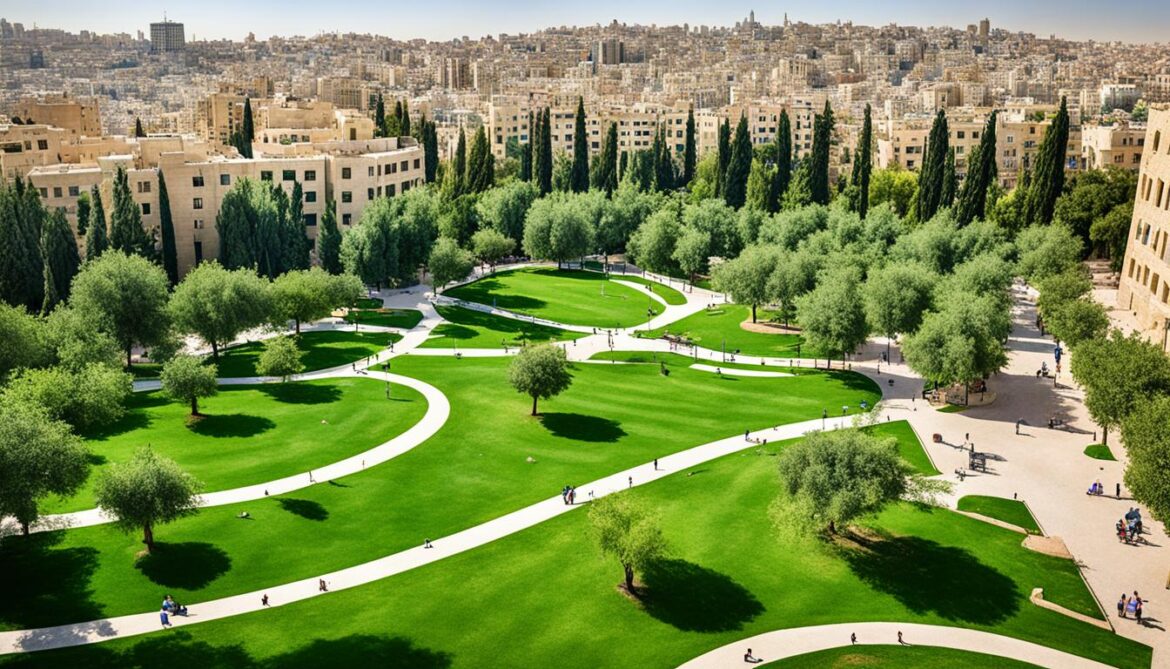
Overall, urban planning initiatives in Jordan are shaping the cities of the future. By prioritizing sustainability, promoting green spaces, developing efficient transportation systems, and optimizing land use, Jordan aims to create cities that not only thrive economically but also foster a harmonious relationship between humans and the environment.
Wildlife Preservation in Urban Landscapes of Jordan
Jordan acknowledges the significance of preserving wildlife in urban landscapes. The country recognizes that urban areas can play a crucial role in supporting biodiversity and promoting a harmonious coexistence between humans and nature. Efforts are being made to create and maintain suitable habitats for urban wildlife, ensuring their survival and enhancing biodiversity in urban landscapes.
One of the key initiatives aimed at wildlife conservation in urban areas of Jordan is the establishment of green spaces. These areas provide essential habitats for a variety of wildlife species. By incorporating trees, shrubs, and other vegetation, green spaces offer shelter, food sources, and breeding grounds for urban wildlife. They act as oases amid the concrete jungles, creating corridors for animals to move between fragmented habitats.
Another important aspect of wildlife preservation in urban areas is the creation of wildlife corridors. These corridors link different green spaces and natural areas, enabling animals to travel and search for resources. Wildlife corridors provide crucial connectivity, allowing wildlife populations to thrive by maintaining genetic diversity and facilitating seasonal movements. They also promote the dispersal of seeds and pollen, contributing to the overall health of urban ecosystems.
| Benefits of Wildlife Preservation in Urban Landscapes | Examples of Urban Wildlife Habitats in Jordan |
|---|---|
| Enhanced biodiversity | Parks and gardens |
| Improved ecological balance | Green roofs and walls |
| Ecotourism opportunities | Urban wetlands and ponds |
| Enhanced quality of life for residents | Biodiversity-friendly road verges and medians |
In addition to green spaces and wildlife corridors, biodiversity-friendly landscapes play a crucial role in urban wildlife conservation in Jordan. These landscapes are designed to accommodate a range of native flora and fauna, replicating natural ecosystems within urban settings. Biodiversity-friendly landscapes include diverse plant species, provide nesting opportunities, and incorporate water features to support various wildlife species.
By recognizing and preserving wildlife in urban landscapes, Jordan aims to create sustainable cities that not only prioritize human well-being but also value and support the natural world. Urban wildlife conservation not only enhances biodiversity but also provides opportunities for residents to connect with nature and experience the beauty and benefits of wildlife within an urban context.
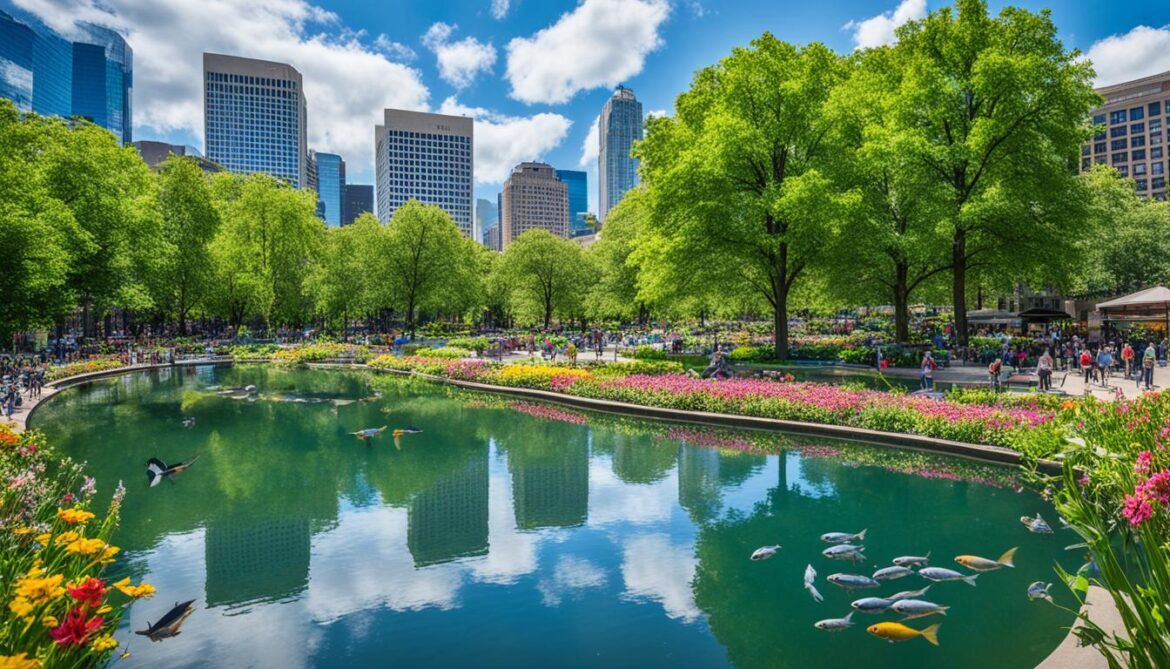
To summarize, wildlife preservation in urban landscapes of Jordan involves creating and maintaining suitable habitats for urban wildlife, including green spaces, wildlife corridors, and biodiversity-friendly landscapes. These initiatives contribute to the survival of native flora and fauna, enhance biodiversity in urban areas, and provide opportunities for residents to experience the wonders of wildlife within their cities.
Ecological Design in Jordan
Ecological design principles are integral to promoting sustainable land use planning and landscape architecture in Jordan. These principles prioritize the conservation and restoration of natural ecosystems, the incorporation of native vegetation, and the promotion of biodiversity. By integrating ecological design into land use planning and development projects, Jordan aims to minimize environmental impact, preserve biodiversity, and create resilient and sustainable landscapes.
Conservation and Restoration of Natural Ecosystems
The ecological design approach in Jordan focuses on preserving and restoring the country’s natural ecosystems. This involves identifying areas of ecological importance and implementing strategies to protect and enhance their ecological value. By recognizing the ecological services provided by these ecosystems, such as nutrient cycling and water filtration, Jordan aims to ensure their long-term sustainability.
Incorporation of Native Vegetation
Incorporating native vegetation is another key aspect of ecological design in Jordan. Native plants have adapted to the local climate, soil conditions, and wildlife interactions, making them better suited for the ecosystem. By using native vegetation in landscaping and urban design, Jordan can support biodiversity, reduce water consumption, and enhance overall ecosystem resilience.
Promotion of Biodiversity
Biodiversity plays a vital role in maintaining healthy ecosystems and supporting various ecosystem services. Ecological design principles in Jordan aim to promote biodiversity by creating habitats that support a wide range of species. This includes designing green spaces, parks, and urban forests that provide food, shelter, and breeding grounds for both native and migratory wildlife.
Quote: “Ecological design in Jordan is a powerful tool in balancing the built environment with nature, ensuring sustainable development while preserving the country’s unique ecosystems.” – Dr. Sami Al-Hasan, Landscape Architect
Applying Ecological Design in Practice
Several projects in Jordan demonstrate the successful application of ecological design principles. For example, the Al Azraq Wetland Reserve incorporates sustainable land use planning to protect migratory birds and their habitats. The Dana Biosphere Reserve implements ecological design principles to conserve biodiversity and support eco-tourism. These projects showcase the effectiveness of ecological design in promoting sustainable development while preserving the natural environment.
| Benefits of Ecological Design in Jordan | Examples |
|---|---|
| Promotes biodiversity conservation | Mujib Nature Reserve |
| Improves ecosystem resilience | Ajloun Forest Reserve |
| Enhances water and soil conservation | Shaumari Wildlife Reserve |
| Reduces the impact of urbanization | Wadi Rum Protected Area |
By embracing ecological design principles in Jordan, the country can achieve sustainable land use planning and landscape architecture that harmonizes with the natural environment. These efforts contribute to the preservation of biodiversity, the overall resilience of ecosystems, and the creation of more sustainable and livable cities.
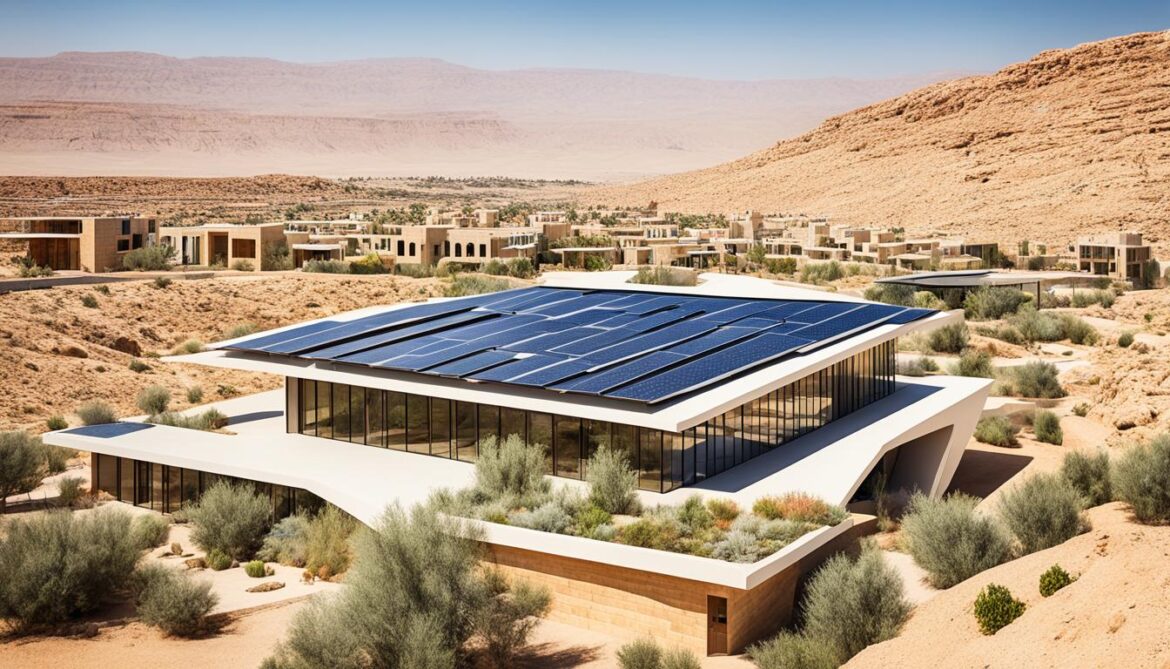
Conclusion
Jordan’s commitment to the preservation of biodiversity and the promotion of sustainable development practices is evident through its conservation efforts, sustainable architecture, urban planning initiatives, and ecological design principles. By establishing nature reserves, Jordan protects its unique ecosystems and wildlife, ensuring their long-term survival. Moreover, the implementation of sustainable architecture and urban planning strategies supports the creation of environmentally-friendly cities that harmonize with the natural surroundings.
Through green infrastructure and sustainable development practices, Jordan aims to minimize the environmental impact on biodiversity, preserving the delicate balance between the built environment and the natural world. Efforts to preserve wildlife in urban landscapes and the integration of ecological design principles in land use planning further contribute to the protection and enhancement of biodiversity in Jordan.
By fostering a sustainable future, Jordan strives to create a harmonious coexistence between humans and the diverse flora and fauna that inhabit its landscapes. The conservation efforts in Jordan, combined with sustainable architecture, urban planning initiatives, and ecological design practices, pave the way for a greener and more resilient future, ensuring the well-being of both present and future generations and preserving Jordan’s unique Biodiversity and the Built Environment.




